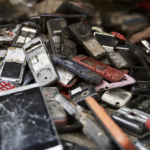The myth of renewable energy
By Dawn Stover | November 22, 2011
“Clean.” “Green.” What do those words mean? When President Obama talks about “clean energy,” some people think of “clean coal” and low-carbon nuclear power, while others envision shiny solar panels and wind turbines. And when politicians tout “green jobs,” they might just as easily be talking about employment at General Motors as at Greenpeace. “Clean” and “green” are wide open to interpretation and misappropriation; that’s why they’re so often mentioned in quotation marks. Not so for renewable energy, however.
Somehow, people across the entire enviro-political spectrum seem to have reached a tacit, near-unanimous agreement about what renewable means: It’s an energy category that includes solar, wind, water, biomass, and geothermal power. As the US Energy Department explains it to kids: “Renewable energy comes from things that won’t run out — wind, water, sunlight, plants, and more. These are things we can reuse over and over again. … Non-renewable energy comes from things that will run out one day — oil, coal, natural gas, and uranium.”
Renewable energy sounds so much more natural and believable than a perpetual-motion machine, but there’s one big problem: Unless you’re planning to live without electricity and motorized transportation, you need more than just wind, water, sunlight, and plants for energy. You need raw materials, real estate, and other things that will run out one day. You need stuff that has to be mined, drilled, transported, and bulldozed — not simply harvested or farmed. You need non-renewable resources:
• Solar power. While sunlight is renewable — for at least another four billion years — photovoltaic panels are not. Nor is desert groundwater, used in steam turbines at some solar-thermal installations. Even after being redesigned to use air-cooled condensers that will reduce its water consumption by 90 percent, California’s Blythe Solar Power Project, which will be the world’s largest when it opens in 2013, will require an estimated 600 acre-feet of groundwater annually for washing mirrors, replenishing feedwater, and cooling auxiliary equipment.
• Geothermal power. These projects also depend on groundwater — replenished by rain, yes, but not as quickly as it boils off in turbines. At the world’s largest geothermal power plant, the Geysers in California, for example, production peaked in the late 1980s and then the project literally began running out of steam.
• Wind power. According to the American Wind Energy Association, the 5,700 turbines installed in the United States in 2009 required approximately 36,000 miles of steel rebar and 1.7 million cubic yards of concrete (enough to pave a four-foot-wide, 7,630-mile-long sidewalk). The gearbox of a two-megawatt wind turbine contains about 800 pounds of neodymium and 130 pounds of dysprosium — rare earth metals that are rare because they’re found in scattered deposits, rather than in concentrated ores, and are difficult to extract.
• Biomass. In developed countries, biomass is envisioned as a win-win way to produce energy while thinning wildfire-prone forests or anchoring soil with perennial switchgrass plantings. But expanding energy crops will mean less land for food production, recreation, and wildlife habitat. In many parts of the world where biomass is already used extensively to heat homes and cook meals, this renewable energy is responsible for severe deforestation and air pollution.
• Hydropower. Using currents, waves, and tidal energy to produce electricity is still experimental, but hydroelectric power from dams is a proved technology. It already supplies about 16 percent of the world’s electricity, far more than all other renewable sources combined. Maybe that’s why some states with renewable portfolio standards don’t count hydropower as a renewable energy source; it’s so common now, it just doesn’t fit the category formerly known as “alternative” energy. Still, that’s not to say that hydropower is more renewable than solar or wind power. The amount of concrete and steel in a wind-tower foundation is nothing compared with Grand Coulee or Three Gorges, and dams have an unfortunate habit of hoarding sediment and making fish, well, non-renewable.
All of these technologies also require electricity transmission from rural areas to population centers. Wilderness is not renewable once roads and power-line corridors fragment it. And while proponents would have you believe that a renewable energy project churns out free electricity forever, the life expectancy of a solar panel or wind turbine is actually shorter than that of a conventional power plant. Even dams are typically designed to last only about 50 years. So what, exactly, makes renewable energy different from coal, oil, natural gas, and nuclear power?
Renewable technologies are often less damaging to the climate and create fewer toxic wastes than conventional energy sources. But meeting the world’s total energy demands in 2030 with renewable energy alone would take an estimated 3.8 million wind turbines (each with twice the capacity of today’s largest machines), 720,000 wave devices, 5,350 geothermal plants, 900 hydroelectric plants, 490,000 tidal turbines, 1.7 billion rooftop photovoltaic systems, 40,000 solar photovoltaic plants, and 49,000 concentrated solar power systems. That’s a heckuva lot of neodymium.
Unfortunately, “renewable energy” is a meaningless term with no established standards. Like an emperor parading around without clothes, it gets a free pass, because nobody dares to confront an inconvenient truth: None of our current energy technologies are truly renewable, at least not in the way they are currently being deployed. We haven’t discovered any form of energy that is completely clean and recyclable, and the notion that such an energy source can ever be found is a mirage.
The only genuinely sustainable energy scenario is one in which energy demands do not continue to escalate indefinitely. As a recent commentary by Jane C. S. Long in Nature pointed out, meeting ambitious targets for reducing greenhouse gases cannot be accomplished with “piecemeal reductions,” such as increased use of wind power and biofuels. Long did the math for California and discovered that even if the state replaced or retrofitted every building to very high efficiency standards, ran almost all of its cars on electricity, and doubled its electricity-generation capacity while simultaneously replacing it with emissions-free energy sources, California could only reduce emissions by perhaps 60 percent below 1990 levels — far less than its 80 percent target. Long says reaching that target “will take new technology.” Maybe so, but it will also take a new honesty about the limitations of technology. Notably, Long doesn’t mention the biggest obstacle to meeting California’s emissions-reduction goal: The state’s population is expected to grow from today’s 40 million to 60 million by 2050.
There are now seven billion humans on this planet. Until we find a way to reduce our energy consumption and to share Earth’s finite resources more equitably among nations and generations, “renewable” energy might as well be called “miscellaneous.”
Together, we make the world safer.
The Bulletin elevates expert voices above the noise. But as an independent nonprofit organization, our operations depend on the support of readers like you. Help us continue to deliver quality journalism that holds leaders accountable. Your support of our work at any level is important. In return, we promise our coverage will be understandable, influential, vigilant, solution-oriented, and fair-minded. Together we can make a difference.
Topics: Climate Change, Columnists















